Related Research Articles

The Back River, formerly Backs River, is the 20th longest Canadian river and is located in the Northwest Territories and Nunavut. It rises at an unnamed lake in the North Slave Region of the Northwest Territories and flows more than 974 km (605 mi) mostly through the Kivalliq Region, Nunavut, to its mouth at the Arctic Ocean in the Kitikmeot Region of Nunavut.

Inuit religion is the shared spiritual beliefs and practices of the Inuit, an indigenous people from Alaska, northern Canada, parts of Siberia, and Greenland. Their religion shares many similarities with some Alaska Native religions. Traditional Inuit religious practices include animism and shamanism, in which spiritual healers mediate with spirits. Today many Inuit follow Christianity ; however, traditional Inuit spirituality continues as part of a living, oral tradition and part of contemporary Inuit society. Inuit who balance indigenous and Christian theology practice religious syncretism.
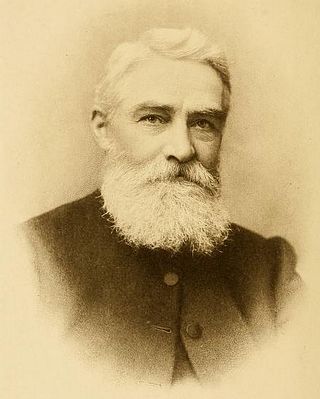
Edmund James Peck, known in Inuktitut as Uqammaq, was an Anglican missionary in the Canadian North on the Quebec coast of Hudson Bay and on Baffin Island. He founded the first permanent mission on Baffin Island, Nunavut. He developed Inuktitut syllabics, derived from the Cree syllabary and the first substantial English-Inuktitut dictionary.
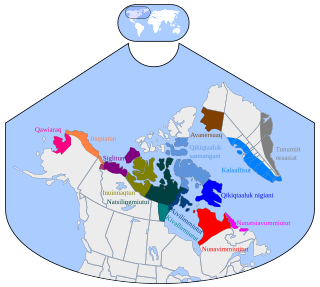
Inuktitut, also known as Eastern Canadian Inuktitut, is one of the principal Inuit languages of Canada. It is spoken in all areas north of the North American tree line, including parts of the provinces of Newfoundland and Labrador, Quebec, to some extent in northeastern Manitoba as well as the Northwest Territories and Nunavut. It is one of the aboriginal languages written with Canadian Aboriginal syllabics.
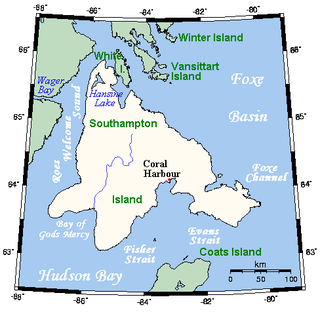
Southampton Island is a large island at the entrance to Hudson Bay at Foxe Basin. One of the larger members of the Arctic Archipelago, Southampton Island is part of the Kivalliq Region in Nunavut, Canada. The area of the island is stated as 41,214 km2 (15,913 sq mi) by Statistics Canada. It is the 34th largest island in the world and Canada's ninth largest island. The only settlement on Southampton Island is Coral Harbour, called Salliq in Inuktitut.

Jessie Oonark, was a prolific and influential Inuk artist of the Utkuhiksalingmiut Utkuhiksalingmiut whose wall hangings, prints and drawings are in major collections including the National Gallery of Canada.
The claim that Eskimo words for snow are unusually numerous, particularly in contrast to English, is a cliché commonly used to support the controversial linguistic relativity hypothesis. In linguistic terminology, the relevant languages are the Eskimo–Aleut languages, specifically the Yupik and Inuit varieties.
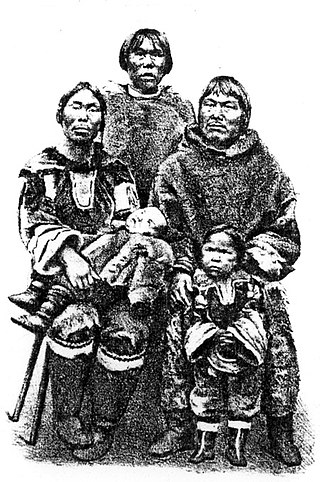
Abraham Ulrikab was an Inuk from Hebron, Labrador, in the present-day province of Newfoundland and Labrador, Canada, who – along with his family and four other Inuit – agreed to become the latest attraction in the ethnographical shows organized by Carl Hagenbeck, owner of the Tierpark Hagenbeck, a zoo in Hamburg, Germany.

Cora Alice Du Bois was an American cultural anthropologist and a key figure in culture and personality studies and in psychological anthropology more generally. She was Samuel Zemurray Jr. and Doris Zemurray Stone-Radcliffe Professor at Radcliffe College from 1954. After retirement from Radcliffe, she was Professor-at-large at Cornell University (1971–1976) and for one term at the University of California, San Diego (1976).

Traditional Alaskan Native religion involves mediation between people and spirits, souls, and other immortal beings. Such beliefs and practices were once widespread among Inuit, Yupik, Aleut, and Northwest Coastal Indian cultures, but today are less common. They were already in decline among many groups when the first major ethnological research was done. For example, at the end of the 19th century, Sagdloq, the last medicine man among what were then called in English, "Polar Eskimos", died; he was believed to be able to travel to the sky and under the sea, and was also known for using ventriloquism and sleight-of-hand.

The Netsilik (Netsilingmiut) are Inuit who live predominantly in Kugaaruk and Gjoa Haven, and somewhat in Taloyoak of the Kitikmeot Region, Nunavut, and, to a smaller extent in the north Qikiqtaaluk Region, in Canada. They were, in the early 20th century, among the last northern indigenous peoples to encounter missionaries from the south.

Kivallirmiut, also called the Caribou Inuit, barren-ground caribou hunters, are Inuit who live west of Hudson Bay in Kivalliq Region, Nunavut, between 61° and 65° N and 90° and 102° W in Northern Canada.

Inuit are a group of culturally and historically similar Indigenous peoples traditionally inhabiting the Arctic and subarctic regions of North America, including Greenland, Labrador, Quebec, Nunavut, the Northwest Territories, Yukon (traditionally), Alaska, and Chukotsky District of Chukotka Autonomous Okrug, Russia. Inuit languages are part of the Eskimo–Aleut languages, also known as Inuit-Yupik-Unangan, and also as Eskaleut. Inuit Sign Language is a critically endangered language isolate used in Nunavut.
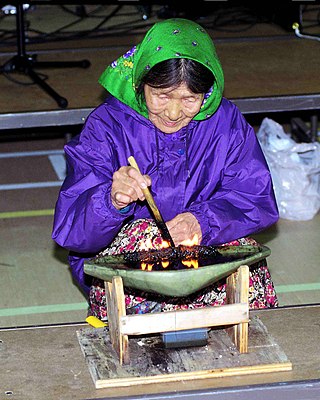
The Inuit are an indigenous people of the Arctic and subarctic regions of North America. The ancestors of the present-day Inuit are culturally related to Iñupiat, and Yupik, and the Aleut who live in the Aleutian Islands of Siberia and Alaska. The term culture of the Inuit, therefore, refers primarily to these areas; however, parallels to other Eskimo groups can also be drawn.

Uvavnuk was an Inuk woman born in the 19th century, now considered an oral poet. The story of how she became an angakkuq, and the song that came to her, were collected by European explorers of Arctic Canada in the early 1920s. Her shamanistic poem-song, best known as "Earth and the Great Weather", has been anthologised many times.
Hugh Brody is a British anthropologist, writer, director and lecturer.
Utkuhiksalik, Utkuhikhalik, Utkuhikhaliq, Utkuhiksalingmiutitut, Utkuhiksalingmiutut, Utkuhiksalingmiut Inuktitut, Utku, Gjoa Haven dialect, is a sub-dialect of Natsilingmiutut (Nattiliŋmiut) dialect of Inuvialuktun language once spoken in the Utkuhiksalik area of Nunavut, and now spoken mainly by elders in Uqsuqtuuq and Qamani'tuaq on mainland Canada. It is generally written in Inuktitut syllabics.
Margaret Lantis was an American anthropologist, Eskimologist, and writer.

The UtkuhiksalingmiutUkukhalingmiut, Utkukhalingmiut —the people of the place where there is soapstone—is one of 48 groups of Inuit in what is now Nunavut, Canada. Their traditional land was around Chantrey Inlet (Tariunnuaq) area, near the estuary of the Back River in, what was then called, the Keewatin District of the Northwest Territories. The Utkuhiksalingmiut followed the traditional hunter-nomadic life moving from fishing the camp near the mouth of the Back River on Chantrey Inlet to their caribou hunting camp in the Garry Lake area, living in winter snow houses (igloos) and caribou skin tents in the summer. They subsisted mainly on trout, whitefish, and barren-ground caribou.
References
- 1 2 3 4 5 6 7 8 9 10 11 12 Gushue, Lisa (2016-07-29). "Eminent anthropologist Jean Briggs, Inuit language expert, dead at 87". CBC News . Retrieved 2016-08-21.
- 1 2 3 4 5 6 7 8 9 10 11 12 13 Sullivan, Joan (2016-08-12). "Anthropologist Jean L. Briggs' books on Inuit became classics". The Globe and Mail . Retrieved 2016-08-21.
- 1 2 3 "Faculty and Instructors: Jean Briggs". Department of Anthropology at Memorial University of Newfoundland . Archived from the original on 2016-10-22. Retrieved 2016-08-21.
- ↑ Sullivan, Joan (2016-08-12). "Anthropologist Jean L. Briggs' books on Inuit became classics". The Globe and Mail. Retrieved 2021-12-30.